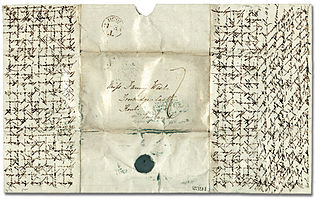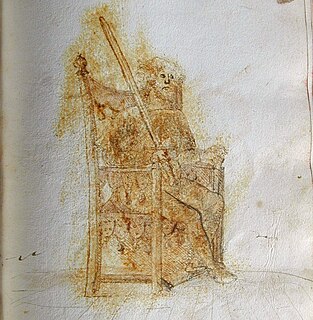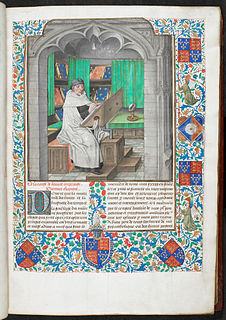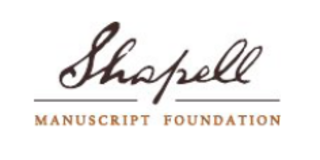 W
WA manuscript was, traditionally, any document written by hand – or, once practical typewriters became available, typewritten – as opposed to mechanically printed or reproduced in some indirect or automated way. More recently, the term has come to be understood to further include any written, typed, or word-processed copy of an author's work, as distinguished from its rendition as a printed version of the same. Before the arrival of printing, all documents and books were manuscripts. Manuscripts are not defined by their contents, which may combine writing with mathematical calculations, maps, music notation, explanatory figures or illustrations.
 W
WAn illuminated manuscript is a manuscript in which the text is supplemented with such decoration as initials, borders (marginalia), and miniature illustrations. In the strictest definition, the term refers only to manuscripts decorated with either gold or silver; but in both common usage and modern scholarship, the term refers to any decorated or illustrated manuscript from Western traditions. Comparable Far Eastern and Mesoamerican works are described as painted. Islamic manuscripts may be referred to as illuminated, illustrated, or painted, though using essentially the same techniques as Western works.
 W
WThis is a list of illuminated manuscripts.
 W
WAn autograph is a person's own handwriting or signature. The word autograph comes from Ancient Greek, and can mean more specifically:a manuscript written by the author of its content. In this meaning the term autograph can often be used interchangeably with holograph. a celebrity's handwritten signature. Autograph collecting is the activity of collecting such autographs.
 W
WAn autograph or holograph is a manuscript or document written in its author's or composer's hand. The meaning of autograph as a document penned entirely by the author of its content, as opposed to a typeset document or one written by a copyist or scribe other than the author, overlaps with that of holograph.
 W
WThe Bodmer Foundation is a library and museum specialised in manuscripts and precious editions. It is located in Cologny, Switzerland just outside Geneva.
 W
WThe Brokmerbrief or Law of Brokmerland is the early 13th-century law code of the brocmanni, the inhabitants of Brokmerland, west of Aurich in East Frisia. The area had been placed under cultivation and settled by the end of the 12th century. It survives in two manuscripts. The work is sometimes referred to as the Brookmerbrief, using the modern spelling of "Brookmerland".
 W
WThe Codex Cumanicus is a linguistic manual of the Middle Ages, designed to help Catholic missionaries communicate with the Cumans, a nomadic Turkic people. It is currently housed in the Library of St. Mark, in Venice.
 W
WThe Codex Tovar, is a historical Mesoamerican manuscript from the late 16th century written by the jesuit Juan de Tovar and illustrated by Aztec painters, intitled Historia de la benida de los Yndios a poblar a Mexico de las partes remotas de Occidente. The codex is close in content, but not identical, to the Ramírez Codex. It is currently kept at the John Carter Brown Library, in Providence.
 W
WCodicology is the study of codices or manuscript books written on parchment as physical objects. It is often referred to as 'the archaeology of the book', concerning itself with the materials, and techniques used to make books, including their binding.
 W
WA crossed letter is a manuscript letter which contains two separate sets of writing, one written over the other at right-angles. This was done during the early days of the postal system in the 19th century to save on expensive postage charges, as well as to save paper. This technique is also called cross-hatching or cross-writing.
 W
WDella mercatura e del mercante perfetto written by Benedetto Cotrugli around 1400 was the first bookkeeping manuscript and trade manual. The title has been translated in English by the alternate names of Of commerce and the perfect merchant, On merchantry and the perfect merchant, and On trade and the perfect dealer.
 W
WEditions des Saints Peres is an independent publishing house specialized in the publication of limited facsimile editions of literary manuscripts. Founded in 2012 by fr:Jessica Nelson and Nicolas Tretiakow, Editions des Saints Peres has published the manuscripts of major literary figures including Charles Baudelaire, Jean Cocteau, Jean-Luc Godard, Jules Verne, Lewis Carroll, and Marcel Proust.
 W
WFonds Coislin is a collection of Greek manuscripts acquired by Pierre Séguier, but named after Henri-Charles de Coislin, its second owner. It is now held in the National Library of France, as one of three fonds of Greek manuscripts: fonds grec, fonds Coislin, and supplément grec.
 W
WFragmentarium is an online database to collect and collate fragments of medieval manuscripts making them available to researchers, collectors and historians worldwide. It is an international collaboration of major libraries and collections including the British Library, Bibliothèque nationale de France, Martin Schøyen Collection, Bavarian State Library, Harvard, Yale and the Vatican. It is based in Switzerland and the project's current director is Professor Christoph Flüeler from the University of Fribourg and the Virtual Manuscript Library, Switzerland.
 W
WThe Holy Cross Sermons are the oldest extant prose text in the Polish language, dating probably from the late 13th, or from the early 14th century. The documents are named after the place where they were originally housed – the Holy Cross Monastery in Poland's Holy Cross Mountains. They were discovered in striped parchment pieces in 1890 by Aleksander Brückner, in the binding of a Latin language codex, which contained the Acts of the Apostles and the Apocalypse. The sermons were first published in 1891, in a "Philological Works" magazine. In 1934, facsimiles of the text were published by the Polish Academy of Learning, and in 2009, new, full edition of the sermons was issued, prepared by professor Paweł Stępień.
 W
WHunminjeongeum is a document describing an entirely new and native script for the Korean language. The script was initially named after the publication, but later came to be known as hangul. It was created so that the common people illiterate in hanja could accurately and easily read and write the Korean language.
 W
WThe Jingjiao Documents are a collection of Chinese language texts connected with the 7th-century mission of Alopen, a Church of the East bishop from Sassanian Mesopotamia, and the 8th-century monk Adam. The manuscripts date from between 635, the year of Alopen's arrival in China, and around 1000, when the cave at Mogao near Dunhuang in which the documents were discovered was sealed.
 W
WA lacuna is a gap in a manuscript, inscription, text, painting, or musical work. A manuscript, text, or section suffering from gaps is said to be "lacunose" or "lacunulose". Some books intentionally add lacunas to be filled in by the owner, often as a game or to encourage children to create their own stories.
 W
WThe Legend of Saint Margaret is an important piece of Mediaeval Hungarian literature. The only specimen of the text was preserved in the Margaret Codex, copied by Lea Ráskay in 1510. The legend tells the life and deeds of Saint Margaret of Hungary.
 W
WLes Vélins du Roi is a compendium of 6984 plant and animal paintings started in 1631 to document specimens from the royal garden and animal collection. Foremost illustrators such as Nicolas Robert, Pancrace Bessa, Gerard van Spaendonck, Claude Aubriet and Madeleine Françoise Basseporte contributed to the codex through the reigns of Louis XIII, Louis XIV and Louis XV, and the codex was finally entrusted in 1793 to the Museum Nationale d’Histoire Naturelle, where it remains.
 W
WLibellus De Arte Coquinaria is a culinary manuscript containing thirty-five early Northern European recipes. The Collection is composed of four versions and consists of recipes in Danish, Icelandic, and Low German. Dating from the early thirteenth century, the libellus is considered to be among the oldest of culinary recipe collections. The cookbook exists in a three-part collection consisting of a book of herbs, one of stones, and Libellus De Arte Coquinaria. The two former are written by Henrik Harpestræng.
 W
WLocationes mansorum desertorum is a manuscript of Nicolaus Copernicus, written between 1516–1521. It is from ledgers handwritten by Copernicus when he was an economic administrator in Warmia.
 W
WLot and his Daughters, with Sodom and Gomorrah Burning is a miniature in pen and watercolour from a very late illuminated manuscript bible. The illustration by Picu Pătruț of Transylvania, begun on May 24, 1842, is one of the 139 miniatures made from 1842 to 1851 for the "Bible of St. Petersburg" from 1819.
 W
WMaithil Karna Kayasthak Panjik Sarvekshan is a book written by Binod Bihari Verma in Maithili. It is a research study on the available ancient manuscripts in the Mithila region, called as Panjis, which are genealogical charts of Maithil Brahmin and Kayasthas castes. This study deals with the manuscripts available in respect of Karna Kayasthas.
 W
WThe Matenadaran, officially the Mesrop Mashtots Institute of Ancient Manuscripts, is a museum, repository of manuscripts, and a research institute in Yerevan, Armenia. It is the world's largest repository of Armenian manuscripts.
 W
WMaya codices are folding books written by the pre-Columbian Maya civilization in Maya hieroglyphic script on Mesoamerican bark paper. The folding books are the products of professional scribes working under the patronage of deities such as the Tonsured Maize God and the Howler Monkey Gods. Most of the codices were destroyed by conquistadors and Catholic priests in the 16th century. The codices have been named for the cities where they eventually settled. The Dresden codex is generally considered the most important of the few that survive.
 W
WMesoamerican codices are manuscripts that present traits of the Mesoamerican indigenous pictoric tradition, either in content, style, or in regards to their symbolic conventions. The unambiguous presence of Mesoamerican writing systems in some of these documents is also an important, but not defining, characteristic, for Mesoamerican codices can comprise pure pictorials, native cartographies with no traces of glyphs on them, or colonial alphabetic texts with indigenous illustrations. Perhaps the best-known examples among such documents are Aztec Codices, Maya Codices, and Mixtec Codices, but other cultures such as the Tlaxcaltec, the Purepecha, the Otomi, the Zapotec, and the Cuicatec, are creators of equally relevant manuscripts.
 W
WThis is a list of printed books, manuscripts, letters, music scores, comic books, maps and other documents which have sold for more than US$1 million. The dates of composition of the books range from the 7th-century Quran leaf palimpsest and the early 8th century St Cuthbert Gospel, to a 21st-century holograph manuscript of J. K. Rowling's The Tales of Beedle the Bard. The earliest printed book in the list is a Southern Song annotated woodblock edition of the Book of Tang printed c. 1234. The first book to achieve a sale price of greater than $1 million was a copy of the Gutenberg Bible which sold for $2.4 million in 1978.
 W
WThe National Mission for Manuscripts (NAMAMI) is an autonomous organisation under Ministry of Culture, Government of India, established to survey, locate and conserve Indian manuscripts, with an aim to create national resource base for manuscripts, for enhancing their access, awareness and use for educational purposes. The Mission was initiated in February 2003, by the Ministry of Tourism and Culture, Government of India and Indira Gandhi National Centre for the Arts (IGNCA) is the nodal agency for the execution of this project. It creates bibliographic databases of Indian manuscripts and is involved in the conservation and preservation of the manuscripts.
 W
WThe Oxyrhynchus Papyri are a group of manuscripts discovered during the late nineteenth and early twentieth centuries by papyrologists Bernard Pyne Grenfell and Arthur Surridge Hunt at an ancient rubbish dump near Oxyrhynchus in Egypt.
 W
WIn textual studies, a palimpsest is a manuscript page, either from a scroll or a book, from which the text has been scraped or washed off so that the page can be reused for another document. Parchment was made of lamb, calf, or goat kid skin and was expensive and not readily available, so in the interest of economy a page was often re-used by scraping off the previous writing. In colloquial usage, the term palimpsest is also used in architecture, archaeology and geomorphology to denote an object made or worked upon for one purpose and later reused for another, for example a monumental brass the reverse blank side of which has been re-engraved.
 W
WPortolan charts are nautical charts, first made in the 13th century in the Mediterranean basin and later expanded to include other regions, which have been noted for their high cartographic accuracy. The word portolan comes from the Italian portulano, meaning "related to ports or harbors", and which since at least the 17th century designates "a collection of sailing directions".
 W
WThe Ramírez Codex, not to be confused with the Tovar Codex, is a post-conquest codex from the late 16th century entitled Relación del origen de los indios que hábitan esta Nueva España según sus Historias. The manuscript is named after the Mexican scholar José Fernando Ramírez, who discovered it in 1856 in the convent of San Francisco in Mexico City.
 W
WSigmund Schining ein Ringeck was a German fencing master. While the meaning of the surname "Schining" is uncertain, the suffix "ain Ringeck" may indicate that he came from the Rhineland region of south-western Germany. He is named in the text of his treatise as Schirmaister to one Duke Albrecht, Count Palatine of Rhine and Duke of Bavaria. Other than this, the only thing that can be determined about his life is that his renown as a master was sufficient for Paulus Kal to include him on his memorial to the deceased masters of the Society of Liechtenauer in 1470. Ringeck seems to have authored one of the few complete glosses of the epitome of the grand master Johannes Liechtenauer, making him one of the most important German fencing masters of the 15th century.
 W
WA rubric is a word or section of text that is traditionally written or printed in red ink for emphasis. The word derives from the Latin: rubrica, meaning red ochre or red chalk, and originates in Medieval illuminated manuscripts from the 13th century or earlier. In these, red letters were used to highlight initial capitals, section headings and names of religious significance, a practice known as rubrication, which was a separate stage in the production of a manuscript.
 W
WSammelband, or sometimes nonce-volume, is a book comprising a number of separately printed or manuscript works that are subsequently bound together.
 W
WThe Schøyen Collection is one of the largest private manuscript collections in the world, mostly located in Oslo and London. Formed in the 20th century by Martin Schøyen, it comprises manuscripts of global provenance, spanning 5,000 years of history. It contains more than 13,000 manuscript items; the oldest is about 5,300 years old. There are manuscripts from 134 different countries and territories, representing 120 languages and 185 scripts.
 W
WScriptorium, literally "a place for writing", is commonly used to refer to a room in medieval European monasteries devoted to the writing, copying and illuminating of manuscripts commonly handled by monastic scribes.
 W
WThe Shapell Manuscript Foundation (SMF) is a non-profit independent educational organization dedicated to research and the collection of historical documents and original manuscripts. The Foundation focuses on the histories of the United States and the Holy Land, with emphasis on the people and events of the 19th and 20th centuries.
 W
WStichometry refers to the practice of counting lines in texts: Ancient Greeks and Romans measured the length of their books in lines, just as modern books are measured in pages. This practice was rediscovered by German and French scholars in the 19th century. Stichos is the Greek word for a 'line' of prose or poetry and the suffix '-metry' is derived from the Greek word for measurement.
 W
WA table-book is a manuscript or printed book which is arranged so that all the parts of a piece of music can be read from it while seated around a table. They were made in the 16th and 17th century for both instrumental and vocal pieces. They are an extension of the idea of Choir books, in which all parts are displayed on one page, in contrast with partbooks, which have a different book for each part and each performer has their own book.
 W
WTimbuktu Manuscripts is a blanket term for the large number of historically important manuscripts that have been preserved for centuries in private households in Timbuktu, Mali. The collections include manuscripts about art, medicine, philosophy, and science, as well as copies of the Quran. The number of manuscripts in the collections has been estimated as high as 700,000.
 W
WThe Turin King List, also known as the Turin Royal Canon, is an ancient Egyptian hieratic papyrus thought to date from the reign of Pharaoh Ramesses II, now in the Museo Egizio in Turin. The papyrus is the most extensive list available of kings compiled by the ancient Egyptians, and is the basis for most chronology before the reign of Ramesses II.